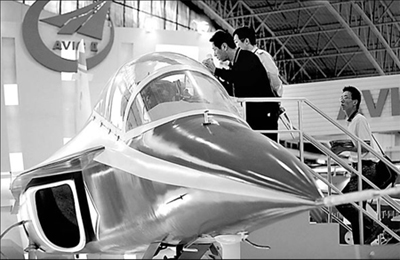
|
BIZCHINA> Center
 |
|
Related
AVIC I & II closer to merger
By Lu Haoting and Xu Dashan (China Daily)
Updated: 2008-06-18 10:16
 A L15 advanced trainer model, manufactured by AVIC II, on display at an exhibition. AVIC I and AVIC II, China's two leading State-owned aviation manufacturers, will be merged to create a new company by the end of July as the government is poised to consolidate and strengthen the country's aviation manufacturing capabilities. Detailed merger plans will soon be approved by the government and the new company is likely to be called China Aviation Industry Group Corp, an official with China Aviation Industry Corp II (AVIC II) told China Daily yesterday. Lin Zuoming, AVIC I president, will be president of the new company, the source said on condition of anonymity. The merger plan comes after the establishment of a company responsible for building large passenger jets last month in Shanghai and is part of the government's commitment to strengthen China's aviation manufacturing capabilities. In the 11th Five-Year Plan (2006-10), China will focus on developing large aircraft, helicopters, civilian aircraft engines and commercial aircraft onboard equipment, according to government sources. Confirming this yesterday, an official with AVIC I said the new company will act as a parent company and a series of new firms specializing in different businesses will be set up under it to manage AVIC I and AVIC II's various companies and subsidiaries across the country. AVIC I and AVIC II are two large State-owned industrial groups reporting directly to the central government. Both have been supplying components to Boeing and Airbus. AVIC I manufactures 50-seat turboprop MA60 and provides components to ARJ 21, China's indigenously developed regional jet with 70-100 seats. AVIC II is the country's only manufacturer of military and commercial helicopters. It also manufactures the 50-seat ERJ 145 regional jet in partnership with Brazilian plane maker Embraer. Both companies are also involved in making non-aviation products such as automobile components and motorcycles. They produce military weapons such as missiles, fighter jets and bombers as well. The two companies were born in 1999 in an industry overhaul that split the former China Aviation Industry Corp into two main blocs. The long-term goal of the merger is to gradually spin off non-core businesses and focus on aviation and military products, the AVIC I source said. "If China wants to shorten its gap with Western countries in aviation manufacturing business, it must consolidate and pool all existing research and manufacturing resources. But now we have two independent companies, which sometimes results in redundancy and waste of resources," said Li Lei, an aviation analyst with CITIC China Securities. "But it is hard to say now whether the merger will necessarily result in higher competitiveness," Li said. (For more biz stories, please visit Industries)
|